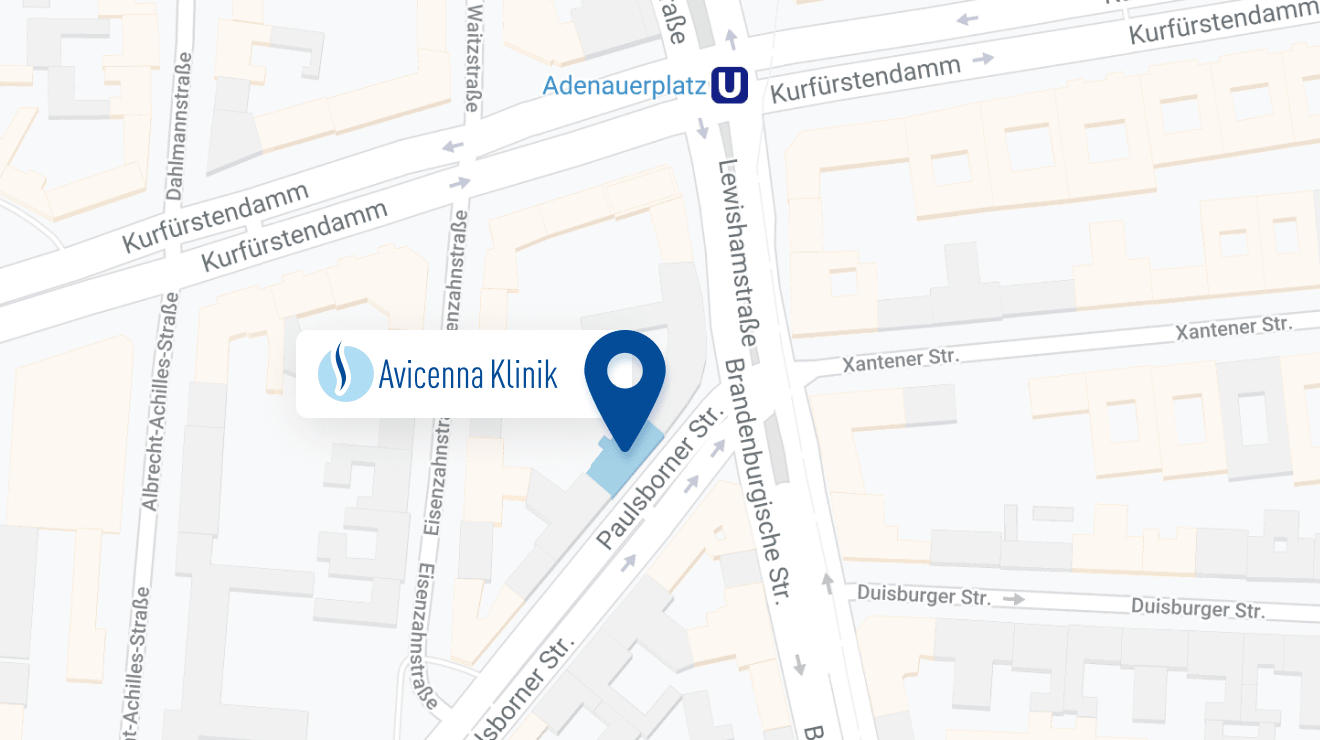Injection or infiltration? That is how you free yourself!
Pain therapies are conservative treatments that are used without surgical intervention to eliminate acute and chronic pain. In addition to medication, injections, physiotherapy or electrotherapy can be used. As part of injection treatments, we inject painkillers and anti-inflammatory drugs directly to the affected nerve roots and thus influence the source of the pain, without putting any pressure on the entire organism. Under CT or MRI control, the injections are placed exactly on the affected nerve root of the lumbar, cervical or thoracic spine. After an extensive diagnosis, we use such a kind of conservative therapy, especially for mild pain or slight spinal column changes. Targeted local infiltrations or injections, in or around the irritated tissue (nerves, joints, tendons, muscles), are now among the most important treatments in medical practice, especially when it comes to successful treatment of inflammatory-activated processes.
Pain is also a warning signal. The important thing is to take this signal seriously. So: go to a doctor (ideally neurosurgeon or orthopedist), when movements and even rest circumstances become an agony. Pain takes people's quality of life away! One more reason to take effective measures to quickly alleviate pain and to sustainably improve the mobility of the respective area. Sure, pain triggers are not completely removed by this - but injections will help you to improve rapid pain relief.
Have you ever wonder why these symptoms are more common for back, neck or joint pain? And why they do not affect just athletes and elderly people? Surely there may be several answers but often the cause lies in our modern lifestyle! We just do not move enough anymore - we just sit too much, often we eat unhealthy and too much. The result is unused muscle groups, incorrect position, overweight and ultimately pain. In other words, you can be your best healer with a responsible life! So if you take care of a healthy, well-balanced diet and adjust it with sufficient exercise, this effectively prevents back and joint problems and ensures a good body sensation.
Now let's say what treatment options we have in modern medicine when pain spoils your everyday life.
Periradicular therapy (PRT) on the spine
The aim of each infiltration and injection treatment is to interrupt the pain in the respective patient, as well as possible in order to prevent chronic pain. Periradicular therapy (PRT) is one of the pain therapies tailored to the spine. We carry this therapy mainly in case of degenerative constrictions of the spinal nerves, after a herniated disc or a disc protrusion, especially when pain radiates to the leg.
In the PRT, the patient is lying on his stomach and under local anesthesia. The action point is disinfected several times and then marked with coordinates. Therapy takes place completely under X-ray, CT or MRI control. In other words, through the screen we will see every tiny millimeter while we push the thin hypodermic needle close to the nerve root with a pain-relieving drug (a mix of topical anesthetic, a cortisone preparation). The patient is thus under complete visual control when the drug begins to act on the nerve root. This therapy can be repeated several times if it does not respond adequately after the first one. The administered drugs work against the irritation, the swelling and against the inflammation of the affected nerve root. Thus it comes to pain relief. The PRT can be used in the lumbar, thoracic and cervical spine sections.
What is a facet joint infiltration?
Whether walking, grasping, bending or turning - the joints in the human body are involved in all our movements. In the course of life countless burdens affect them. Wear and tear are therefore a normal process of aging, visible not only in the large joints such as the shoulder, hip and knee joint, but also in the small joints - for example on the feet and toes.
In the spine, the small joints between the vertebrae, the so-called facet joints, have a special meaning. We talk about Facet Joint Infiltration when facets cause discomfort, back problems, often due to arthrosis of the facets, when they are irritated, and when, among other things, there is a painful inflammation. Facet joint infiltration is a therapy that treats the inflammation and swelling of nerves and surrounding tissue. The infiltration is associated with significant pain relief. Before the infiltration is performed, the patient's skin is disinfected and anesthetized, so that the patient does not fell pain. The injection of the drug - a locally acting anesthetic and an anti-inflammatory drug - takes only a few moments. Thereafter, the puncture site is covered with a sterile plaster and thus protected. Infiltrations are not taken into consideration in case of infectious diseases, pregnancy or patients with heart failure. Even patients who take anticoagulant drugs should tell their doctor necessarily. Then he can decide if an infiltration is still possible or if it should be excluded. The most common indications for facet infiltration in the spine are pain caused by wear and arthritis of the small vertebral joints.
How does a cortisone injection work?
It's not a secret, but it does say it all the time: cortisone - in our case cortisone therapy - does not fix the causes. It just effectively combats the symptoms, such as pain and inflammation, and the troubled patient may expect cortisone therapy to restore mobility and quality of life. How long? Up to three or four months. If the cause is not resolved within this period, new cortisone therapy may be considered. Cortisone injection may also be a useful therapy to bridge the phase until the final (possibly operative) therapy.
Cortisone therapy for joint diseases has several names: cortisone injection, corticoidal crystal suspension). As a drug of choice cortisone is often used for osteoarthritis or rheumatism, herniated discs or sports injuries (e. g. tennis elbow). Causes can be: overexertion, age-related wear and tear, often due to incorrect workloads. The advantage of cortisone, which is injected directly into the joint: the active ingredient can fight pain and inflammation exactly where it is needed. Important to know: pain is basically an alarm signal - they say which part of the body is currently under stress and that it makes sense to avoid very specific burdens. That is to say that the patient should think about how he can avoid straining his spine.
Hyaluronic acid therapy - how does an injection work?
In hyaluronic acid therapy, it is similar to cortisone injection: it is a symptom-oriented therapy. It does not work directly against the cartilage wear of the joints, but it can help to strengthen the cartilage formation in the body. This means that it improves cartilage nutrition and protects it. Hyaluronic acid, the most important component of synovial fluid, is the actual "lubricant" in the joint, its motor oil. If the lubricity of the articular surfaces (e. g. in the case of arthrosis) is no longer sufficient, then the hyaluronic acid can improve the situation and compensate for the negative consequences of its missing. The injection, which is given through the disinfected skin in the joint, is called Viscosupplementation. A single injection will usually not be enough to sustainably improvement of pain and inflammation. Normally, two to five injections per week (within 14 days) are necessary to get in the direction of a successful treatment. In some patients, for whom osteoarthritis has not progressed very far, we recommend an injection at intervals between 9 and 12 months.
Advantages/Complications - be a responsible patient
Our life is made of two poles, two different paths to follow, two alternatives. Medicine is not an exception, unfortunately. Basically, you should assume that all the therapies we have outlined here are designed to relieve you from pain. This works in most cases - but not always. There can never be a guarantee of success. Although in isolated cases, complications are behind the corner. Normally they are nothing to worry about, but they are always complications.
It is therefore of particular importance that you consult your doctor thoroughly after the diagnosis and before the therapy. He can clearly explain to you which treatment is the most meaningful and most promising because he knows, from his experience, what side effects might occur. You should know this before the therapy begins. We like to talk to responsible patients. Ask your question, they will be answered.
The Avicenna Clinic in Berlin is always willing to help you
Since the year 2001, the Avicenna Clinic is based in Berlin. Our doctors have at least 25 years of international experience in their respective fields (neurosurgery, spinal surgery, anesthesia, and orthopedics).
If you have severe back pain, a herniated disc or a suspected herniation, please contact us using the following information:


